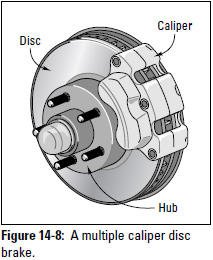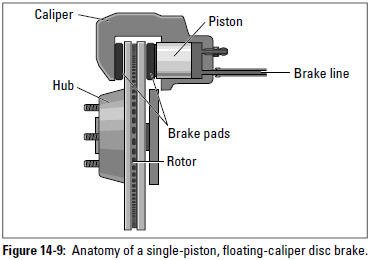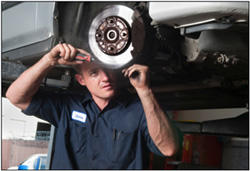Disc brakes used to be found mainly on the front wheels of vehicles, with drum brakes at the rear. Today most passenger vehicles have disc brakes all around. Each brake has a flat steel disc — you knew that, right? — sandwiched between a pair of calipers (see Figure 14-8) or a single caliper (see Figure 14-9). These calipers contain one or more pistons that force the brake fluid in the brake lines into the disc. Between the disc (sometimes called a rotor) and the pistons are brake pads, which operate in the same way that brake shoes do: They grab the disc with their friction linings and force the disc to stop turning, which in turn forces the wheel to stop turning and the vehicle to stop moving. The effect is the same as on a bicycle when the brakes grab the wheel directlyto stop it from turning.
 |
Older vehicles use fixed-caliper brake systems in which one or two pistons on each side of the disc push the pad against it. A single-piston floating-caliper disc brake system is becoming increasingly popular (see Figure 14-9). When you apply the brakes, the caliper moves from side to side and centers itself. Because these systems are self-adjusting, more reliable, and less expensive,they'll probably become the standard.
 |
Car Smarts: Disc brakes have advantages over drum brakes. Because they operate in the open air (instead of inside brake drums), they're less prone to overheating. They're also less affected by water because the leading edge of each brake pad scrapes the water away before it can get between the pads and the disc. (When drum brakes get wet, the brake linings may not grab the brake drumsatisfactorily and the car may not stop.)
From Auto Repair for Dummies, copyright © 2009 by Wiley Publishing, Inc., Indianapolis, Indiana. Used by arrangement with John Wiley & Sons, Inc.











